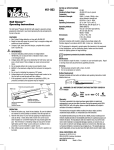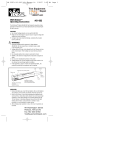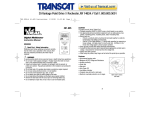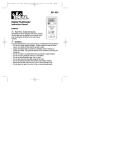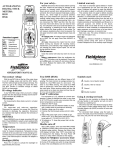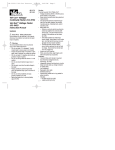Download OPERATING INSTRUCTIONS FOR POCKET DIGITAL
Transcript
Dimensions: 125mm (H) x 60mm (W) x 24mm (D). Weight: Approx 110g including batteries and case. (Accuracy at 23°C + - 5°C, <75% R.H.) 450V DC or AC rms 450V DC or AC rms Test current 1.2mA Response Time: 500ms Audible indication: < 25Ω +- 3.0% rdg + 4 dgts +- 5.0% rdg + 5 dgts +- 3.0% rdg + 3 dgts Open circuit Volts -0.45 Vdc 450V DC or AC rms +- 2.0% rdg + 4 dgts 9.1MΩ Open circuit Volts -1.2 Vdc +- 2.0% rdg + 5 dgts 10MΩ NON-CONTACT VOLTAGE INDICATOR: Detects voltage from 70V to 600V AC 50Hz -60Hz Battery Life: 70 hours continuous operation. +- 4.0% rdg + 5 dgts Temperature Co-efficient: 0.1 x (specified accuracy) per °C. (0°C to 18°C, 28°C to 40°C). Power: Two 1.5 button-type batteries (IEC# LR-44, NEDA # 1166A). 9.1MΩ 600V DC or AC rms Accuracy Storage Temperature: -20°C to + 60°C at < 80% R.H. with battery removed from meter. +- 2.0% rdg + 2dgts Operating Environment: 0°C to +40°C at <70% R.H. Diode Test Continuity Measuring voltage which exceeds the limits of the multimeter may cause damage to the meter and expose the operator to a shock hazard. Always be aware of the meter voltage limits as stated on the front of the meter. Auto Power Off: approx. 10 minutes. OHM When using the probes, keep fingers behind the finger guards. Measurement Rate: 2 times per second, nominal. 1mV 10mV 100mV 1V 1mV 10mV 100mV 1V 100mΩ 1Ω 10Ω 100Ω 1kΩ 10kΩ 10mV 1Ω Use caution when working above 60V DC or 30V AC rms. Such voltages pose a shock hazard. Low Battery Indication: The “ + - “ is displayed when the battery voltage drops below the operating level. Resolution Turn off power to the circuit before cutting, desoldering, or breaking the circuit. Small amounts of current can be dangerous. Overrange: “OL” mark indication. 4V 40V 400V 600V 4V 40V 400V 600V 400Ω 4kΩ 40kΩ 400kΩ 4MΩ 40MΩ 2V 400Ω Never ground yourself when taking electrical measurements. Do not touch exposed metal pipes, outlets, fixtures, etc., which might be at ground potential. Keep your body isolated from ground by using dry clothing, rubber shoes, rubber mats, or any approved insulating material. Polarity: Automatic, positive implied, (-) negative polarity indication. Range Do not use if meter or test leads look damaged, or if you suspect that the meter is not operating properly. ACV (50-60Hz) Display: 3 1/4 digit liquid crystal display (LCD) with a maximum reading of 3999 Overload Protection The following safety information must be observed to ensure maximum personal safety during the operation of this meter. 10MΩ SPECIFICATIONS Input Impedance SAFETY INFORMATION DCV OPERATING INSTRUCTIONS FOR POCKET DIGITAL MULTIMETER WAT115A MEASURING RESISTANCE & TESTING CONTINUITY: OPERATION Before using meter please read the Safety Information section. Always examine the meter for damage, contamination (excessive dirt, grease, etc.) and defects. Examine the test leads for cracked or frayed insulation. If any abnormal conditions exist do not attempt to use. AUTORANGING: The meter defaults to autorange when you turn it on. In autorange, the meter selects the range automatically. DATA HOLD FEATURE: Press (HOLD) button to toggle in and out of the Data Hold mode. In data hold mode, “HOLD” and the last reading are displayed. Press (HOLD) button again to release. The hold and current reading are once again displayed. MODE SWITCH (DC/AC): When the function switch is set to ( Ω / )) / ) position press button to toggle between DC and AC in the voltage measurements. Press this switch to toggle between the continuity/diode and ohms modes. ) MEASURING VOLTAGE: 1. Set the Function Switch to “VOLT” position. 2. To toggle between “DC” & “AC”, press Mode switch. The “DC to “AC” mark is displayed. 3.Touch the probes to the test points, the range will change automatically to the level that will display the best input voltage resolution. 4. The value indicated in the display window is the measured value of voltage. 1. Set the Function Switch to ( Ω / )) / ) position. 2. Turn off power to the circuit under test. External voltage across the components causes invalid readings. 3.To toggle between the ohms/continuity/diode modes, press Mode Switch. 4. Touch the probes to the test points. In ohms, the value indicated in the display is the measured value of resistance. In continuity testing, the beeper sounds continuously, if the resistance is less than approximately 25Ω ) TESTING DIODES 1. Set the Function switch to ( Ω / )) / ) position. 2. Turn off power to the circuit. External voltage across the components causes invalid readings. 3. To toggle between the ohms/continuity/diode modes press Mode Switch. 4. Touch probes to the diode. A forward-voltage drop is about 0.6V (typical for a silicon diode). 5. Reverse probes. If the diode is good, “OL” is displayed. If the diode is shorted, a value near 0mV will be displayed. 6. If the diode is open, “OL” is displayed in both directions. 7. Audible Induction: Less than 0.25V. ) NON-CONTACT VOLTAGE INDICATOR: BATTERY REPLACEMENT: 1. Store the test leads on back of meter before taking NCV measurement. 2. Set switch to OFF/NCV position. Press and hold the NCV button and aim sensor to the object to be detected. When a voltage is detected, the NCV LED and beeper will stay on. NOTE: If battery is low, beeping sound may be less audible and may not work. Replace batteries in this instance. Power is supplied by two 1.5V button type batteries (NEDA 1166A, IEC LR-44). “ + - “ Symbol appears when battery needs replacing. AUTO POWER OFF: 1. Power turns off automatically after 10 minutes. 2. Press (HOLD) button to restart and display last measurement reading. WARNING Before attempting to replace the batteries disconnect the Test Leads from any energised circuit first. 1. Disconnect the test leads from any energised circuit. 2. Set the Function Switch to OFF. 3. Remove battery cover screw. 4. Slide off battery cover and change batteries. 5. Replace battery cover and screw back. BATTERY REPLACEMENT DIAGRAM SAFETY: Conforms to IEC1010-1 (EN61010-1), Rev-2; CATII 600V, CATIII 300V; Class 2, Pollution degree II. Screw EMC: Conforms to EN61326. The symbols used for this instrument are: ! ∼ Caution, refer to accompanying documents. Equipment protected throughout by Double insulation (Class II) Alternating current. Direct current Ground Battery Compartment Cover



